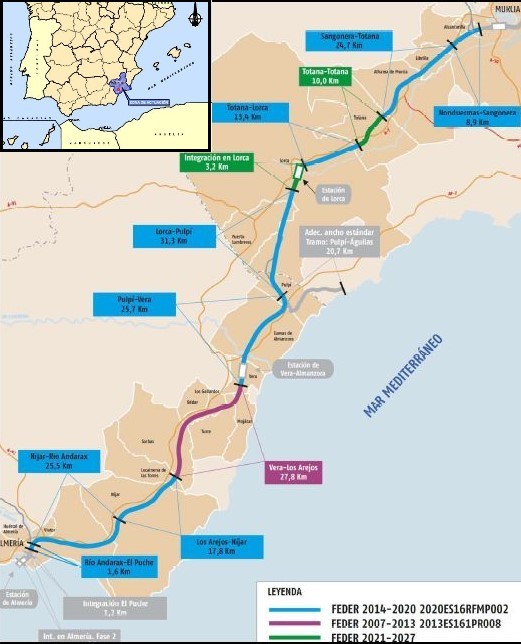The EU is funding the construction of the Nonduermas-Vera and Los Arejos-El Puche sections of Spain’s Murcia-Almería high-speed railway line. The line will be a core part of the Mediterranean Corridor of the Trans-European Transport Network (TEN-T).
- 16 March 2023
Work under the project involves laying 105.32 km of double-track equivalent (length of covered sections is 148.9 km, mostly double track but single track in some sections, all with a standard railway gauge), electrification and installation of signalling and telecommunications equipment. It includes acquisition of property and replacement of affected transport services.
Filling a gap
There is currently no railway directly connecting Murcia and Almería, and passengers and goods travelling between Almería and other large cities in eastern Spain must go via Madrid. The project thus fills a gap in the rail network in south-eastern Spain, and the EU considers the development of the line a priority.
The whole line will be electrified and equipped with a European Rail Traffic Management System level 2 signalling system, communication and safety technology. Fences on both sides of the track and the absence of level crossings along the entire line will increase safety.
The railway is designed to accommodate passenger trains of up to 400 m and freight trains of up to 750 m in length. Passenger trains will be able to travel at over 250 km/h and freight trains up to 100 km/h.
Better services
Railways in the Mediterranean Corridor run along the Mediterranean coast of Spain and pass through France, Italy, Slovenia, Croatia and Hungary, ending at the Hungarian-Ukrainian border. An additional branch of the corridor in Spain starts from Algeciras, passing through Córdoba, Madrid and Zaragoza, before joining the Mediterranean coast branch in Catalonia.
Development of the Mediterranean Corridor will increase railway capacity, making long-distance passenger services more frequent and reliable, optimising rail operations and shortening journey times between major cities in the corridor.
Use of the standard gauge throughout the corridor will ensure interoperability and eliminate bottlenecks caused by the need to transfer freight between trains at the Spanish-French border.
Construction of the Murcia-Almería line will provide rail links to the corridor for areas that currently lack them and facilitate goods transport by connecting railway stations, ports and logistics centres along Spain’s Mediterranean coast to the TEN-T network. It will also allow for the establishment of a new connection between Almería and the centre of the Iberian Peninsula, which will shorten journey times on that route.
The project should make railways more attractive for people and goods, reducing emissions from road transport. In addition, better transport links between south-western Europe and the economic centre of the EU will boost economic activity.
Total investment and EU funding
Total investment for the project “Mediterranean Corridor – Murcia-Almería line: Nonduermas-Vera and Los Arejos-El Puche sections” is EUR 3 848 361 037, with the EU’s European Regional Development Fund contributing EUR 410 700 000 through the “Multiregional” Operational Programme for the 2014-2020 programming period. The investment falls under the priority “Promoting sustainable transport and removing bottlenecks in key network infrastructures”.

